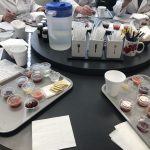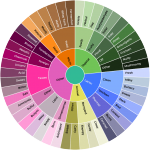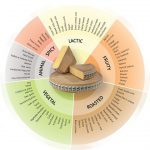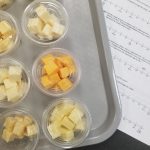Sensory Evaluation of Dairy Products

What is sensory evaluation?
The term “sensory evaluation” refers to the practice of using the five human senses (smell, taste, touch, hearing, and sight) to evaluate the characteristics of food products. Sensory evaluation comes in many shapes and sizes! Here at the Sensory Service Center, we have two main types of evaluation:
- Consumer Testing
- Descriptive Analysis
Consumer testing is done by everyday people who come in to our lab and taste test products. We ask questions about how much you like the product, or how likely you are to purchase it. If you’re interested in participating in these tests, you can click here to find out more.
Descriptive analysis (DA) panels like the one at NCSU are made up of specialized individuals who have been trained to detect and quantify flavors. These panels are designed to create profiles of products- they never answer questions about liking or purchase intent, just about intensity of characteristics.
Why do we use sensory evaluation for dairy products?
Long story short, sensory evaluation is used to help make products the best they can be. Evaluation can be used to understand defects or describe and quantify positive characteristics that increase liking of the product.
Most products get evaluated in one way or another, but dairy products often require special training to evaluate because of their complex nature.
Click on each category to learn more!
What exactly are dried dairy ingredients?
Some you see at the grocery store- things like nonfat dry milk powder or whey protein powder. Others, like milk protein isolate or dry buttermilk, you might never see on the shelf- these are ingredients that are added to other food products to enhance their flavor or nutritional content. If you want to learn more about dried dairy ingredients, the Center for Dairy Research at the University of Wisconsin-Madison has a great slide deck that goes into more detail. You can find it here.
Sensory analysis of dried dairy mostly focuses on the aroma and appearance characteristics of the product. Testers look for a clean milk aroma with no serious defects. Sometimes these products can smell grassy or caramelized, which can indicate problems in the way they were processed.
A good chocolate milk will have a warm, dark brown color that is consistent across the whole sample- there should be no blotchiness, banding of color, or visible graininess to the sample. After checking its appearance, evaluators will assess its aroma using a wheel like the one shown above. The sample should have a distinct chocolate aroma without being too strong or too weak. Any atypical aromas (cardboard, coconut, etc.) are noted. Finally, the judges will taste the milk to evaluate its mouthfeel and taste characteristics. Chocolate milk should be about as thick as whole milk and have a pleasant cocoa taste with a moderate level of sweetness. Evaluators make notes on how they feel the chocolate milk performs with respect to these qualities, and then make notes on any off-flavors they detect in the sample.
Fun fact: Chocolate milk sometimes contains an off flavor that most judges call “bandage” or “band-aid.” It’s exactly what it sounds like- this defect tastes the way a Band-Aid smells! Gross! Bandage defects come from chemical compounds called phenols.
Cheese takes so many different forms that often evaluators use specific terms in order to properly evaluate samples. For example, mozzarella, Swiss cheese, and cheddar each have their own lexicons!
Sensory evaluation of cheese takes three distinct forms:
Cheese is also often evaluated by professional judges in competitions. These judges are more interested in detecting off-flavors or defects in the cheese as part of their judgement. Have you ever heard of the International Cheese Awards? This competition takes place in the United Kingdom every year, and over 5,000 cheeses get submitted for judging! You can see photos from this competition in the photo gallery at the bottom of this page.
Next time you bite into a piece of cheese, think carefully about what it tastes like, and how it feels in your mouth. Interested in learning more about cheese flavors? Check out the cool infographics in our photo gallery at the bottom of the page!
Ice cream taste tester- otherwise known as the best job in the world!
While it’s easy to say whether you like ice cream or not, an objective judging of ice cream can be difficult since it’s such a complex product. One of the most important characteristics of ice cream is its texture. Ice cream should have a smooth, creamy texture that melts evenly in the mouth. Factors that affect ice cream texture include the amount of air and the size of ice crystals in the product. “Fluffy” ice cream has too much air in it, and “sandy” or “gritty” ice cream contains overgrown ice crystals.
You can evaluate ice cream at home yourself! Next time you eat ice cream, let a bite of it sit on your tongue and observe how it melts in your mouth. Think carefully about the texture- does it seem perfectly smooth or can you feel ice crystals?
See sensory evaluation in action! Check out these images:
Image Sources:
“Descriptive Analysis” photo taken by Lauren Sipple, NCSU
“Cheese Flavor Wheel” from https://www.cheesescience.org/wheel/
“NCSU’S Descriptive Analysis Panel” photo taken by Lauren Sipple, NCSU
“Cheese Aroma Wheel” from https://culturecheesemag.com/cheese-bites/comte-cheese-association-updates-aroma-wheel
“Cheese Texture Evaluation” photo taken by Clara Racette, NCSU
“Judging at the International Cheese Awards” from https://hodgepodgedays.co.uk/food/international-cheese-awards-2018/
“NCSU’s Taste Testing Booths with Special Lighting” photo taken by Clara Racette, NCSU






